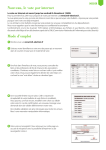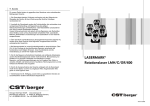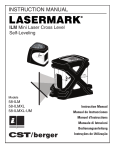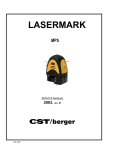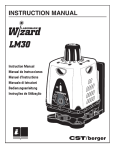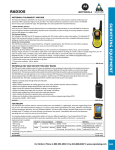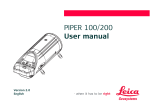Download INSTRUCTION MANUAL - Field Environmental Instruments, Inc.
Transcript
INSTRUCTION MANUAL LMH Series Automatic Self-Leveling Rotary Laser with Universal Laser Detector Copyright© 2002 CST/Berger. All rights reserved The information contained herein is propietary information of CST/Berger, and is subject to change without notice. This document shall not be copied or otherwise reproduced without CST/Berger's written consent. Thank you for purchasing the LaserMark® LMH Automatic Self-Leveling Rotary Laser. Please read this manual thoroughly before operation. CONTENTS 1. LMH Features ................................................................................ 1 2. Laser Safety ................................................................................... 4 3. LMH Operation .............................................................................. 4 3.1 3.2 3.2.1 3.3 3.4 3.5 Leveling ........................................................................................................... 4 Re-leveling ....................................................................................................... 5 Axis Drive Error (Spindle Error) ....................................................................... 5 Anti-Drift System (ADS) ................................................................................... 5 Grade Mode: Single Axis Grade (LMH-GR and LMH600 Only) .......................... 6 Grade Mode: Dual Axis Slope (LMH600 Only) .................................................. 8 4. LMH Applications .......................................................................... 9 4.1 4.2 4.3 Procedures for Ceiling Grid Applications ....................................................... 9 Procedures for Laydown Applications ......................................................... 10 Procedures for General Construction Applications ..................................... 11 5. LMH Battery Replacement ....................................................... 12 6. LMH Calibration .......................................................................... 13 6.1 6.1.2 6.1.3 6.2.1 6.2.2 Upright Position Peg Test (X axis) ................................................................. Upright Position Calibration - X axis (LMH, LMH-C, LMH-GR) ....................... Upright Position Peg Test and Calibration - Y axis (LMH, LMH-C, LMH-GR) . Upright Position Calibration (LMH600) ......................................................... Laydown Position Calibration (LMH600) ....................................................... 7. Care of LMH Instrument ............................................................ 18 8. LMH Specifications ..................................................................... 18 9. Troubleshooting ......................................................................... 19 13 14 15 16 17 10. Warranty ...................................................................................... 20 11. Universal Laser Detector .......................................................... 22 1.1 LMH AND LMH-C FEATURES Rotating Laser Head Battery Low LED Anti-Drift System On LED Power On LED Power On/Off Button Anti-Drift System On/Off Button Battery Compartment Access/ ⁄ " x 11 Tripod Mounting Thread 58 SIDE VIEW LOCATION OF CALIBRATION BUTTONS Built-In Handle 1 1.2 LMH-GR FEATURES Rotating Laser Head Anti-Drift System On LED Battery Low LED Power On LED Made in USA Power On/Off Button Anti-Drift System On/Off Button LMH -GR ANTI-DRIFT SYSTEM POWER Manual Grade Button (See LMH600) Manual Grade Adjustment Buttons LEVEL ON/OFF Manual Grade Setting Made in USA Battery Compartment Access/ ⁄8" x 11 Tripod Mounting Thread 5 LMH -GR ANTI-DRIFT SYSTEM POWER SIDE VIEW LEVEL ON/OFF Manual Grade Setting Built-In Handle LOCATION OF CALIBRATION BUTTONS 2 1. LMH600 FEATURES Self-Leveling Rotating Laser Head Power On/Off Button Power On LED Battery Low LED Out-of-Level Indicator LED LM600 Self-Leveling Rotary Laser Scan Mode Button Scanning to Preset Angles of 10º, 15º, 45º, 90º and 180º to Increase Visibility Variable Speed Rotation Button Four Speed Selection. Speed Decreases Each Time Button is Pressed 90º 45º 15º Manual Grade Button Turns unit to manual mode to allow manual grade setting 180º Manual Grade/Slope Setting Buttons Head Positioning Button for Fast and Easy Alignment in Vertical/ Horizontal Applications, Clock-Wise and CounterClock-Wise Rotation. Pressing and Holding Button Moves the Rotating Beam more Quickly Auto Beam Positioning Button. Positions the Laser Dot in Plumb Down Position (Vertical Mode), for Vertical Laydown Set-ups Battery Compartment Access/ ⁄ " x 11 Tripod Mounting Thread 58 LM600 Self-Leveling Rotary Laser 90º 45º 15º 180º X Y LOCATION OF CALIBRATION BUTTONS 3 2. LASER SAFETY The use of controls, adjustments, or the performance of procedures other than those specified herein may result in hazardous radiation exposure. Do not stare into the laser beams. Do not disassemble the instrument or attempt to perform any internal servicing. Repair and servicing of this laser are to be performed only by CST or authorized service centers. This laser complies with all applicable portions of title 21 of the Code of Federal Regulations set by the Dept. of Health, Education, and Welfare, the Food and Drug Administration, the Center for Devices, and the Bureau of Radiological Health. 3. LMH SERIES OPERATION 3.1 Leveling 1: Remove the LaserMark® LMH from its case. The unit is shipped with a battery current protection insert, which must be removed before operation. The unit can stand alone on a level, sturdy surface or be secured to a 5 ⁄8" x 11 surveyor’s tripod. Power On (if blinking, unit is self-leveling) 2: Press the Power button once, and allow time (up to 30 seconds) for the unit to selfFig. 1 level. The Power On LED (Fig. 1) and the laser will blink during this process. Please note, the laser head may begin to rotate before leveling is complete. The self-leveling speed is approximately 1° per 4 seconds. 3: After self-leveling, the laser head will rotate at 600 RPM. Press the Power button again to turn the unit off. (Note: for LMH-GR and LMH600 models, see section 4.3.2 (page 11) 4 3.2 Re-leveling If the unit is bumped or moved, the unit will automatically attempt to re-level itself. The Power On LED and the laser will blink during this process until the unit is level once again. The laser head will resume rotation at 600 RPM. Note: For the LMH-GR and LMH600, if the unit is bumped or moved while in Manual Grade mode, the unit will not re-level itself. On the job site, it may be necessary to prevent re-leveling in order to prevent inaccurate measurements by the opAxis Drive Error erator. The LMH’s Anti-Drift System (Section (Blinking) 3.3) is used for this purpose. 3.2.1 Axis Drive Error (Spindle Error) If the LMH is set up or tipped beyond its selfleveling range of ±5°, the laser head will initially attempt to level; however, when the selfleveling limit is reached, the Battery Low and Anti-Drift System LEDs will blink, indicating an axis drive error (Fig. 2). Turn the LMH off, move the unit into a more level position, then turn the unit on again. 3.3 Anti-Drift System (ADS) This function is prompted by pressing the Anti-Drift System button; it clearly signals the operator when the unit is moved out of position. The ADS LED will remain lit. Fig. 2 Anti-Drift System On (Re-level unit if blinking) Fig. 3 With ADS on, when the H.I. (“height of instrument”) of the unit is altered due to tripod movement or an accidental bump, the laser head will stop rotation, the laser will blink, and both the Power On and ADS LEDs will blink. The operator must attend to the unit to affect the relevel process by pressing the ADS button once. Pressing the ADS button twice will turn the ADS feature off. The default setting is ADS off; the laser will automatically re-level itself when the unit is moved out of level. ADS is always reset to off when power is turned off. 5 Y -A x is 3.4 Grade Mode: Single Axis Grade (LMH-GR and LMH600 Only) The single grade function is ideal for general site grading, checking excavations, landscaping and drainage, and more. Manual grade mode can be activated by placing the automatic leveling sensor in the OFF position. Pressing the manual grade button will deactivate the sensor. NOTE: The total percent grade possible is LMH-GR from a perfectly level base position. If the unit is mounted on a tripod head which is not perfectly level, then the grade percentage range capable would be reduced by the slope of the base, as this affects the tilt range of the laser head. For maximum grade range, ensure a level tripod head using a spirit level before mounting your unit. LMH600 The selected grade can be as much as a positive or negative 10%, and set in reference to the Y-axis of the unit. Operator can use one of two methods to generate single-axis grade (Fig. 4). Method 1: Place the unit in the middle of the two points (A and B) to get a higher distance. Method 2: Place the unit at one point (A) and locate the other point (B). On the LMH600, you may first press Variable Rotation button and set the laser to the desired rotation speed. Press the "MANUAL GRADE" button to activate Manual Grade Option. Press the ARROW buttons (Fig. 5B) to adjust to your desired grade. A B "Y" Axis Beam from Pivot Point = 2.2" Method 1 Method 2 Fig. 4 6 The unit will react to "MORE" and "LESS" input (Fig 5A and 5B). Allow the unit ample time to react to the input provided, between grade setups or changes. Fig. 5A “MORE” “MORE” “LESS” “LESS” X Y LMH600 Only The Rotating Head tilts on the X-Axis. The LEFT ARROW tilts in the "LESS" direction. LMH600 Only: In Laydown, the Top Plumb Beam moves from left to right. LMH-GR and LMH600 LM600 Self-Leveling Rotary Laser 90º 45º 15º The Rotating Head tilts on the Y-Axis. The UP ARROW tilts in the "MORE" direction. LMH600 Only: In Laydown, the Top Plumb Beam moves upward. Made in USA LMH -GR 180º The Rotating Head tilts on the X-Axis. The RIGHT ARROW tilts in the "MORE" direction. LMH600 Only: In Laydown, the Top Plumb Beam moves from left to right. The Rotating Head tilts on the Y-Axis. The DOWN ARROW tilts in the "LESS" direction. LMH600 Only: In Laydown, the Top Plumb Beam moves downward. Fig. 5B 7 ANTI-DRIFT SYSTEM POWER LEVEL ON/OFF Manual Grade Setting 3.5 Grade Mode: Dual Axis Slope (LMH600 Only) The dual grade function allows more specialized site preparations such as road grading, airport jobs (grading & paving), irrigation, trenching, landfills, slopes and embankments, and pipelaying. To enter a dual grade setting, press the Manual Mode (Grade) button. Then press the ARROW buttons to adjust grade (Fig. 5B). Allow the unit ample time to react to the button being pressed. Refer to examples in Fig. 6 to predict your results. Y+ X+ X- Y+ X- Y Target Y+ X+ X Y+ X+ X- Y- X= –10.00% Y= –10.00% YY+ X+ X- Y- Y+ X- X= +10.00% Y= +10.00% X+ Y- X= –10.00% Y= +10.00% Fig. 6 8 4. LMH SERIES APPLICATIONS Use your LaserMark® LMH Series Automatic Self-Leveling Laser for these and many other projects: Outdoor General Construction Applications & Site Preparation, Grading & Excavating, Batterboards and Foundations, Masonry Work, Setting Concrete Forms, Machinery Installation, Marking Elevation, Septic Work, Paving Roads, Driveways, Checking Depth of Trenches. 4.1 Procedures for Ceiling Grid Applications (LMH600 Only) 1: Attach the LMH Series to the optional wallmount bracket. Be sure the control buttons are facing outward. Tightening the locking screw will secure the unit to the bracket. 2: After installing the first piece of ceiling trim, attach the wallmount to it. Be sure the wallmount is secure to the trim. 3: Press the Power button. If the out-of-level indicator is blinking, press the manual grade button to put the unit into automatic mode. Allow the unit to self-level. 4: Adjust the distance of the unit from the grid, typically 1.5-inch (38mm) below the grid. Loosen the adjustment screw and slide the unit up/down on the wall mount. When the desired height has been reached, tighten the adjustment screw to secure 9 the unit. 5: Install the ceiling grid. Attach the magnetic laser target to the ceiling trim being installed. Adjust the height of the trim until the laser beam strikes the target. Note: Placing the unit into Scan Mode will make installation easier and more effecient. To place the unit in Scan Mode, press the Scan Mode button until the rotating laser head stops. Press and hold either clock-wise or counterclock-wise Head Positioning button until the laser beam moves to the working area. Press the Scan Mode button until the rotating beam is scanning the necessary angle. 4.2 Procedures for Laydown Applications (LMH600 Only) 1: Place the unit in the laydown position on a flat, level surface. 2: Press the Power button. If the "Out-of-Level" indicator is blinking, press the Manual Grade button to put the unit in automatic mode. 3: Press the Auto Beam Positioning button; the laser beam will plumb down over point. 4: Use the left and right Manual Grade buttons for fine adjustment. LMH600 Shown 10 4.3 Procedures for General Construction Applications Note: A level plane of laser light is created by the rotating beam of the LMH Series. The laser light can be used to reference elevations with the use of a laser detector. 1: Place the unit on a flat, level surface such as a tripod. Setup the unit in an area where it can not be obstructed and it will be set at a convenient height. 2: Press the Power button. If the "Out-of-Level" indicator (LMH-GR and LMH600 only) is blinking, press the Manual Grade button to put the unit in automatic mode. 2a: LMH600 Only – Press the Variable Speed Rotation button to select the desire rotation speed of the laser head. 3 : Take elevation readings using the plane of laser light as a reference. To take readings, attach the laser detector to the grade rod and place the rod at a point to for an elevation reading. Follow the Detector Operation Procedures in this manual. 11 5. LMH SERIES BATTERY REPLACEMENT Your LaserMark® level will provide approximately 30 hours of intermittent use (variable with temperature) with four Alkaline “D” cell batteries. If the Battery Low LED is lit (Fig. 7), or the LMH operates erratically, try replacing the batteries. Low Battery 1: Remove the battery tray by unscrewing the plastic nut around the mounting thread on the bottom of the unit (Fig. 8). 2: Remove the old batteries and replace with four new “D” cell Alkaline batteries. Fig. 7 3: Replace the battery tray. Make sure the battery contacts between the battery pack and the unit compartment are aligned. NOTE: Do not mix old and new batteries. Replace all batteries at the same time with new batteries. Remove batteries before storage of the instrument. Rechargeable Battery Pack if you are using a rechargeable battery pack (included with Cat. #57-LMHD [120V] or #57-LMHE [230V]), your LMH will provide approximately 14 hours of intermittent use with each full charge. The batteries will begin to perform optimally after five full charges and discharges. You may charge the battery pack within the LMH. Ensure that the power is off, and connect the charging plug to the charging jack on the bottom of the battery pack. Then plug the charger into the appropriate 120/230V AC outlet. Charge time is typically around 8 hours. The LMH can be charged and used at the same time, but only a minimal charge will be applied to the battery pack. Fig. 8 12 6. LMH SERIES CALIBRATION Your LaserMark® level is a sealed unit and is calibrated to precise accuracies at the factory. However, a calibration check is recommended before the initial use of your laser, and then periodically from that point forward. Be sure to allow time (up to 30 seconds) for the unit to completely self-level before each check. Y+ X- Please note the direction of the X and Y axes for the unit (Fig. 9). You will need to refer to this to complete the following steps. X+ Y- Fig. 9 6.1 Upright Position Peg Test (X axis) 1: To test the X axis, mount the LaserMark® on a tripod or a level, sturdy surface and place approximately 100 feet (30m) away from 100' a wall. Face the right side of the unit (30m) (X+ quadrant) to the wall. 2: Press the POWER button and allow the unit to self-level. Using the laser detector, locate and mark the position of the laser line on the wall (“A”, Fig. 10). A B 3: Loosen the LaserMark® from the tripod and rotate the instrument Fig. 10 180°. Ensure that the height of the tripod does not change, as this will affect your results. Secure and relevel the unit. 4: Again, locate and mark the position of the laser line on the wall (“B”). No adjustment is necessary if the vertical difference between A and B is less than 1/8" (3.5mm) Repeat the above steps to ensure a correct reading. If the distance is greater than 1/8", you will need to calibrate the X axis (next refer to 6.1.2; for LMH600, refer to 6.2.1). 13 6.1.2 Upright Position Calibration - X axis (LMH, LMH-C, LMH-GR) 1: Keep the unit in its current position. Power Off the unit. Calibration Mode X Axis active 2: Power On the unit while holding the ADS button down. You will know if Calibration mode is activated when the Battery Low and ADS LEDs flash alternately. Then, the ADS LED will remain lit; this indicates that the unit is calibrating within the X axis (Fig. 11). 3: Locate the position of the two calibration Fig. 11 buttons as shown in (Fig. 12), on the LMHGR the UP and DOWN ARROW buttons change the axis increments. The upper button will produce a positive (+) 4: You must raise or lower the beam to center between points A and B on the wall (Fig. 13). The unit will react to “+” and “–” input within the X- quadrant, with each single increment moving the beam approximately 1/32" at 100 feet. If B is below A, decrease the increment (-). If B is above A, increase the increment (+). 5: The adjustments are automatically saved. You must now repeat the peg test (6.1) to insure you have made the correct calibration. Repeat calibration if necessary. B Calibrated A Fig. 13 X- facing the wall LMH and LMH-C Fig. 12 14 6.1.3 Upright Position Peg Test and Calibration - Y axis (LMH, LMH-C, LMH-GR) If you wish to test the Y axis at the same time as the X axis, simply keep the unit on from when you tested the X axis and rotate the unit 90° so that the front of the unit is facing the wall. Press the ADS button to turn the ADS LED off; you are now calibrating within the Y axis (Fig. 14); follow 6.1, steps 2 through 4. If you are testing the Y axis at a later time than the X axis, mount the LaserMark® on a tripod and place approximately 100 feet (30m) away from a wall, with the front (Y– quadrant) of the unit facing the wall; follow 6.1, steps 2 through 4. A Calibration Mode Y Axis active Calibrated B Fig. 15 Y+ facing the wall Fig. 14 Calibrate as in 6.1.2, adjusting “+” and “–” input as necessary within the Y+ quadrant (Fig. 15). If you are unable to calibrate the unit, or if the difference between points A and B is too great to calibrate within the range of the unit, please contact CST/Berger or an authorized service center for assistance. 15 6.2.1 Upright Position Calibration (LMH600) 1: Keep the unit in its current position. Power OFF the unit. Y+ 2: Power ON the unit while holding the ClockWise button down. You will know if Calibration mode is activated when the Battery Low and Out- Xof-Level LEDs flash alternately. Then, the Power LED will remain lit. X+ Y- 3: The ARROW buttons will produce the increment change as shown in figure 17. Fig. 16 4: follow 6.1.2, steps 4 through 5. Rotate unit 90 degree to calibrate the other axis. 5: Press the POWER button. This will exit Calibration Mode. Y+ X+ X- Y+ Fig. 17 16 6.2.2 Laydown Position Calibration (LMH600) 1: Place the unit in the laydown position on a flat, level surface 100 feet (30 meter) from a wall (Fig. 18). 2: Press and hold the Counter-Clockwise Button, and then press the Power Button. Release both button at the same time. The Out-of-Level LED and Battery Low indicators blink together, Then the Power indicator illuminates. Note: For the most accurate check, allow the unit to operate for at least 30 seconds before continuing. 3: Place a plumb line at the wall (Fig. 18). 4: Have the rotating beam scan the wall and physically adjust the unit so the beam is in-line with the plumb line. 5: If the beam is not in-line with the plumb line, use the UP ARROW and DOWN ARROW buttons to adjust the beam, until it intersects the plumb line. Plumb Line 6: Press the POWER button. This will exit Calibration Mode. Rotating Beam (Dashed Line) is shown NOT in-line with plumb line Plumb Beam Fig. 18 17 7. CARE OF LMH INSTRUMENT Always clean the instrument after use. Use a soft, dry cloth to remove any dirt or moisture from the instrument. Do not use benzene, paint thinner, or other solvents to clean the instrument. Remove batteries before storage of the instrument. 8. LMH SERIES SPECIFICATIONS Description Leveling Accuracy LMH LMH-C LMH-GR LMH600 ±1⁄ 16" @100' ±1.5mm@30m ±3⁄ 32" @100' ±2.4mm@30m) ±1⁄ 16" @100' ±1.5mm@30m) ±1⁄ 16" @100' ±1.5mm@30m) Recommended Working Range Up to 2000' (610m) diameter with laser detector Laser Diode Visible Red Beam 650 NM Self-Leveling Range ±5º Self-Leveling Speed 650 NM 635 NM 635 NM ±3º ±5º ±5º 1º per 4 sec. (approx.) 8" h X 6-1⁄ 4" w X 6-3⁄ 8" d (203mm X 159mm X 162mm) Dimensions Weight 5.5± lbs. (2.5kg) with batteries Power Four (4) D cell Alkaline batteries or rechargeable battery pack Battery Life Rotation Speed Operating Temperature 75± hours intermittent use with Alkaline batteries (variable with temperature); 14+ hours used w/fully charged battery pack. 600 RPM 600 RPM 600 RPM Variable 0,150,300,600 RPM 22ºF to 120ºF (-6ºC to 49ºC) 18 9. TROUBLESHOOTING The following information lists basic tests that can be performed to check the LMH in the event of poor performance. Check Your Batteries: One of the most common causes of performance failures is due to defective or incorrectly installed batteries. Check to see if any batteries are installed backwards and correct if necessary. • Never selectively replace batteries; always replace all of the batteries at the same time with new batteries. It is recommended, if possible, that the batteries be checked with a voltmeter or battery tester to confirm proper voltage. • Leaky batteries may have damaged the battery contacts in the battery box. • Check to see that the battery tray is screwed tightly onto the base of the unit. Also, the fit between the battery prongs and the batteries may need adjustment, as this fit may vary over different brands of battery (especially Energizer™ brand, as they are larger in diameter, preventing a proper connection). • Alkaline batteries are recommended for the best performance and storage life. Rechargeable batteries such as Nickel-Cadmium will provide performance, but are not as desirable due to their lower terminal voltage. Low cost standard Carbon-Zinc batteries may be used in emergencies, but they should be replaced with alkaline batteries when available. Rechargeable Battery Pack: For maximum battery life, the battery pack must contain a full charge. Properly charged, the battery pack will provide approximately 14 hours of service. As in most Ni-Cd battery packs, the closer to a full charge that the pack has, the longer it will take to attain a full charge. The batteries will begin to perform optimally after five full charges and discharges. Unit does not rotate or self-level, or produces Axis Drive Error: Reset the internal processor by turning power off and on again. You may also try removing the battery tray for 5 seconds to let the 19 capacitor discharge, then replace the tray and try again. If the unit rotates but does not self-level, be sure that the Anti-Drift System is turned off. LMH600 Errors: When an error occurs on the LMH600, turn the unit OFF. Wait 5 seconds, then turn unit ON. If error still occurs, press the Grade Mode button. Use the ARROW buttons to rotate the laser head. Then turn unit OFF and then ON again. If these procedures do not correct error, contact CST/berger. X—AXIS ERROR Y—AXIS ERROR SPINDLE ERROR 20 10. WARRANTY This LaserMark® LMH Automatic Self-Leveling Rotary Laser is warranted to the original purchaser to be free from defects in workmanship and material. CST/Berger will repair or replace any defective part which may malfunction under normal and proper use within a period of TWO YEARS from the date of purchase without charge of parts and labor, once delivered and shipped prepaid to CST together with proof of date and place of purchase. This warranty is not subject to misuse, abuse, assignment, or transfer. The exclusive remedy under any and all warrants and guarantees, expressed or implied, is limited to repair and/or replacement as provided herein, and CST shall not be liable for damages from loss or delay of equipment uses, consequential, or incidental damage. Before returning the unit to CST/Berger, please call (800) 4351859 for a return authorization number from our Customer Service Department. Please fill out and return the attached warranty registration card. 21 Universal Laser Detector 1. INTRODUCTION The LaserMark® Universal Laser Detector aids in locating and targeting a visible or invisible beam emitted by a rotary laser; perfect for use in outdoor conditions, where sunlight and distance may make locating the beam more difficult. 2. FEATURES LD400 SHOWN LD400 Includes heavy-duty rod clamp. Beam Capture Window LCD Readout Window 50 mm (2.0 in) Power ON/OFF Beam Resolution Volume ON/OFF Speaker LCD Readout Window Made in USA Battery Door 3. POWER A 9-volt battery will provide up to 3 months of typical usage. When the unit is turned on and the low battery symbol remains lit, the battery should be replaced. 22 4. OPERATION 1: Mount the unit onto a sighting rod if you are using one. Turn on the unit by pressing the ON/OFF pad. The LCD symbols will momentarily flash (Fig. 1) and the “coarse” beam indicator symbol will remain lit and the audio signal will be on. 2: Expose the beam capture window of the laser detector towards the direction of the rotating laser. LCD Display Beam Resolution High Beam Level Beam Indicator Low Beam Speaker Volume Battery Strength 3: Slowly move the laser detector in an Fig. 1 upward and downward direction until the LCD beam indicator arrows appear and/or a pulsing audio signal is heard. Use the Beam Resolution feature to choose between the coarse/low setting, used for approximating level or for initial locating of the center level point, the medium setting, used for greater accuracy, and the fine/high setting, used for the most accurate pinpointing of level. 4: Move the detector upward when the low beam indicator light is lit (with volume on, a short pulsing audio tone is heard). Move the detector downward when the high beam indicator arrow is lit (with volume on, a long pulsing audio tone is heard). When the beam is level, the level beam indicator line will be lit and a solid audio tone will be heard. If the detector is not struck by a laser beam after 5-8 minutes, the detector will automatically shut itself off to preserve battery life. Turn the unit back on using the power button. 23 5. SPECIAL FEATURES This detector has a unique memory feature, which preserves the last position of the laser beam if the detector is moved out of the plane of laser light, as well as built in electronic filtering for bright sunlight and electromagnetic interference. Three distinct audio tones (high, ongrade, and low) assist targeting from a distance. Features speaker Off, Loud (105 dBA) and Louder (125+ dBA), fine, medium, and coarse beam resolution settings, and front and back LCD displays. Seven distinct channels of information (Fig. 2) indicate the Fig. 2 position of the detector in the plane of laser light. As you move the detector closer to the center, the arrows fill in to indicate the laser position. 6. CARE OF YOUR UNIVERSAL LASER DETECTOR This unit is gasket sealed for water and dust protection. Use a soft, dry cloth to remove any dirt or moisture from the instrument before storage. Do not use benzene, paint thinner, or other solvents to clean the instrument. Remove battery before long-term storage of the instrument. 7. SPECIFICATIONS Dimensions: 6.6" h x 3" w x 1" d (169mm x 76mm x 25mm) Weight: 10 oz. (275g) Range: up to 2000' (610m) Beam Detection Sensitivity: Fine, ± .75mm; Medium, ± 1.5mm; Coarse, ± 3mm (sensitivity based on standard conditions with most lasers; may vary slightly due to make, manufacturer, beam size, or working conditions) Readout: LCD, LD400-front and rear windows; LD100N-single window Power: One 9-volt battery; provides 3 months of typical usage 24 Printed in USA PG 0402 Z93-57-LMHMANUAL




























